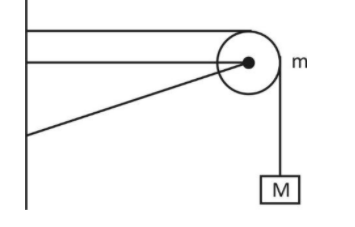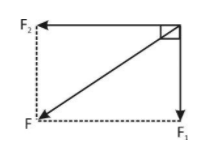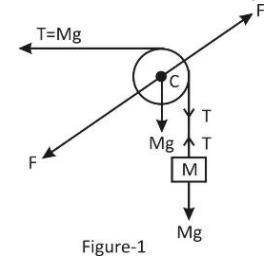
A string of negligible mass going over a clamped pulley of mass m supports a block of mass M as shown in the figure. The force on the pulley by the clamp is given by:
A. $\sqrt 2 Mg$
B. $\sqrt 2 Mg/k$
C. $g\sqrt {{{\left( {M + m} \right)}^2} + {m^2}} $
D. $g\sqrt {{{\left( {M + m} \right)}^2} + {M^2}} $


Answer
577.5k+ views
Hint: When two forces are acting at right angle, then resultant of the force is given by, \[F = \sqrt {{F_1}^2 + {F_2}^2} \]
The normal force always passes through the centre of the disc.
At equilibrium the not force into the system is zero.

Complete step by step solution:
Let tension in the string is T and force applied by pulley by the clamp is F. The free body diagram (FBD) of the system is given below:


The total downward force into the system is ${F_1} = Mg + mg$ or ${F_1} = (M + m)g$ and the total horizontal force working on system is $T = Mg$ (see figure 1 and figure 2)
The force by pulley on clamp and by clamp on pulley will be equal and opposite.
Now, the resultant of vertical and horizontal force will be applied by clamp on pulley.
Now the force on the pulley by the clamp is given by from figure 2,
\[
F = \sqrt {{F_1}^2 + {T^2}} \\
F = \sqrt {{{\left[ {\left( {M + m} \right)g} \right]}^2} + {{\left( {Mg} \right)}^2}} \\
\]
$
= \sqrt {{{\left( {M + m} \right)}^2}{g^2} + {M^2}{g^2}} \\
F = \left[ {\sqrt {{{\left( {M + m} \right)}^2}} + {M^2}} \right]g \\
$
Hence, option (D) is correct.
Note: Note: The tension (T) in string is defined as “the force exerted by a string when it is subjected to pull”. Practically, if a person is holding a block of some weight attached to the one end of a staring then the force experienced by the person is Tension (T).
The normal force always passes through the centre of the disc.
At equilibrium the not force into the system is zero.

Complete step by step solution:
Let tension in the string is T and force applied by pulley by the clamp is F. The free body diagram (FBD) of the system is given below:


The total downward force into the system is ${F_1} = Mg + mg$ or ${F_1} = (M + m)g$ and the total horizontal force working on system is $T = Mg$ (see figure 1 and figure 2)
The force by pulley on clamp and by clamp on pulley will be equal and opposite.
Now, the resultant of vertical and horizontal force will be applied by clamp on pulley.
Now the force on the pulley by the clamp is given by from figure 2,
\[
F = \sqrt {{F_1}^2 + {T^2}} \\
F = \sqrt {{{\left[ {\left( {M + m} \right)g} \right]}^2} + {{\left( {Mg} \right)}^2}} \\
\]
$
= \sqrt {{{\left( {M + m} \right)}^2}{g^2} + {M^2}{g^2}} \\
F = \left[ {\sqrt {{{\left( {M + m} \right)}^2}} + {M^2}} \right]g \\
$
Hence, option (D) is correct.
Note: Note: The tension (T) in string is defined as “the force exerted by a string when it is subjected to pull”. Practically, if a person is holding a block of some weight attached to the one end of a staring then the force experienced by the person is Tension (T).
Recently Updated Pages
Why are manures considered better than fertilizers class 11 biology CBSE

Find the coordinates of the midpoint of the line segment class 11 maths CBSE

Distinguish between static friction limiting friction class 11 physics CBSE

The Chairman of the constituent Assembly was A Jawaharlal class 11 social science CBSE

The first National Commission on Labour NCL submitted class 11 social science CBSE

Number of all subshell of n + l 7 is A 4 B 5 C 6 D class 11 chemistry CBSE

Trending doubts
What is meant by exothermic and endothermic reactions class 11 chemistry CBSE

10 examples of friction in our daily life

One Metric ton is equal to kg A 10000 B 1000 C 100 class 11 physics CBSE

1 Quintal is equal to a 110 kg b 10 kg c 100kg d 1000 class 11 physics CBSE

Difference Between Prokaryotic Cells and Eukaryotic Cells

What are Quantum numbers Explain the quantum number class 11 chemistry CBSE




